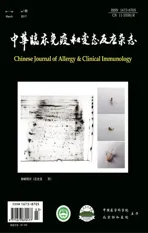调节性B细胞与系统性红斑狼疮
2017-04-11朱丽,何岚
朱 丽,何 岚
(西安交通大学第一附属医院风湿免疫科, 西安 710061)
B细胞为多效性细胞,传统认为,B细胞主要通过产生抗体及递呈抗原在免疫相关性疾病中发挥致病效应。但是新近的研究发现,B细胞可以产生多种细胞因子,其中产生白细胞介素10(interleukin 10,IL- 10)的B细胞能够抑制炎症反应,从而在自身免疫中发挥负向调节功能,这种特殊的B细胞亚群被命名为调节性B细胞(regulatory B cells, Bregs)。深入研究Bregs及其在系统性红斑狼疮(systemic lupus erythematosus, SLE)中发挥功能的作用机制,有助于了解B细胞亚群的功能,为探索SLE新的治疗策略提供依据,本文就Bregs的来源、表型、功能及其在SLE中的研究进展作一综述。
Bregs的发现
早在1974年,Katz等[1]就发现清除掉B细胞的脾脏细胞移植进入天竺鼠体内后,这些脾脏细胞不再能阻碍迟发型高敏反应症(delayed-type hypersensitivity,DTH)的皮肤反应,这项研究首次提出了B细胞在免疫反应中具有抑制免疫应答的作用,同时发现,DTH的皮肤反应发生于抗体产生之前,进一步说明B细胞的抑制功能并非由抑制性抗体发挥;2002年,Mizoguchi等[2]通过肠炎模型,发现了一种能够产生IL- 10的B细胞亚群,这种细胞亚群通过下调促炎因子IL- 1及阻止信号转导子和转录活化子3(signal transducer and activator of transcription 3,STAT3)的活化阻止肠道炎症的进展;Mizoguchi和Bhan[3]于2006年将这群具有负向调节功能的B细胞命名为“调节性B细胞”。随后,在SLE、实验性自身反应性脑脊髓炎(experimental autoimmune encephalomyelitis,EAE)、接触性过敏性皮炎(allergic contact dermatitis,ACD)和胶原诱导性关节炎(collagen induced arthritis,CIA)等免疫相关性疾病中均发现了Bregs的存在。
Bregs的表型
目前对Bregs表型的确定尚存在争议,不同的研究中确定的Bregs表型不同。目前在动物和人类研究中的表型见表1。Saraiva和O’Garra[11]发现在野生鼠和人类CD19转基因(human CD19 transgenic,hCD19Tg)鼠脾脏中分泌IL- 10的B细胞主要为表型为CD5+CD19hi的B- 1a细胞,且这些B细胞还高表达CD1d。在人类的CD19+IL- 10+B细胞也表达高水平的CD1d,Blair等[7]发现表型为CD19+CD24hiCD38hiB细胞中含有丰富的IL- 10+B细胞。而Iwata等[12]通过表型筛选发现,无论在健康对照还是患有自身免疫性疾病的患者体内表型为CD19+CD24hiCD27+的B细胞中IL- 10+B细胞所占的比例均最多。
目前还未发现Bregs的独特表型,在B细胞发育的各个阶段都存在能够产生IL- 10的细胞亚群,其表达不同的表型。对Bregs表型的确定还有待进一步研究。
Bregs的功能
Bregs主要通过分泌IL- 10、白细胞介素35(interleukin 35,IL- 35)及转化生长因子β(transforming growth factor β,TGF-β)发挥抗炎功能。IL- 10的抗炎作用由多种机制介导,其在先天性免疫和获得性免疫中均发挥重要作用。
在先天性免疫中的作用
Gu等[13]发现 IL- 10能够下调促炎因子如γ-干扰素(interferon-γ,IFN-γ)、肿瘤坏死因子α(tumor necrosis factor α,TNF-α)、IL- 17等的产生;随后的研究发现IL- 10降低主要组织相容性复合体(major histocompatibility complex Ⅱ,MHC Ⅱ)分子和共刺激分子表达[11];并抑制树突状细胞(dendrtic cells,DCs)递呈抗原[14]。另外,由DCs产生的IL- 10对于维持Foxp3的表达和调节性T细胞(regulatory T cell,Tregs)的功能非常重要[14- 15]。

表1 人及动物外周血中调节性B细胞亚群的表型Table 1 Phenotype of Breg subsets in peripheral blood of human and animal
IL- 10:白细胞介素10;TGF-β:转化生长因子β;Tregs:调节性T细胞; CTLA- 4:细胞毒T淋巴细胞相关抗原4
在获得性免疫中的作用
IL- 10改变CD4+T细胞的分化。Ding等[16]发现IL- 10能够抑制Th0细胞向Th1分化而促进其向Th2分化,从而影响Th1/Th2细胞平衡。共培养鼠CD1dhiCD5+B细胞和原始CD4+T细胞后,CD4+T细胞向Th17细胞的分化减少[13]。在人类的研究中发现,表型为CD19+CD24hiCD27+的B细胞通过分泌IL- 10阻碍单核细胞产生TNF-α[12]。此外,Bregs还能够影响Tregs的形成。Tadmor等[17]发现和野生鼠相比,缺乏CD19+B细胞的μMT鼠的Tregs的数目明显下降,且患有EAE的鼠病情明显加重,由此提出B细胞具有维持Tregs稳定的作用。随后的研究发现,T2-MZP Bregs可通过诱导CD4+CD25+Foxp3+Tregs在肺部的浸润,从而控制过敏性气道炎症,抑制鼠的过敏反应及气道高反应性[18]。
Bregs和SLE
Bregs在SLE动物模型中的研究
Bregs首次在Palmerston north鼠中发现,将鼠B细胞经过CpG刺激后产生IL- 10的水平明显增加。对SLE的两种鼠模型NZB/W F1 和MRL/lpr进行研究发现,在NZB/W F1鼠12~14周时,用单克隆抗体CD20单抗清除成熟B细胞能够延长NZB/W F1鼠的存活时间,并增加鼠的总体存活率;但是,在NZB/W F1 SLE鼠第4周时,用CD20单克隆抗体消耗B细胞会导致该鼠存活率的下降,同时还导致Tregs水平的下降[19]。这说明B细胞除了产生致病作用外,还存在保护效应。
为了进一步探究具有保护效应的B细胞在SLE中的作用,比较NZB/W F1野生鼠和CD19-/-NZB/W F1鼠的患病情况,发现CD19-/-NZB/W F1鼠的蛋白尿增加,肾小球性肾炎增加,同时生存率下降,同时比较CD19-/-NZB/W F1鼠和NZB/W F1野生鼠中的Bregs的数目,发现CD19-/-NZB/W F1鼠中Bregs数目明显减少,且表现在表型CD1dhiCD5+的Bregs的缺失[14]。而将野生型NZB/W F1鼠的脾脏CD1dhiCD5+B细胞转入CD19-/-NZB/W F1鼠中后会导致其病情好转,同时Tregs的比例增加[20],Bregs部分通过促进Treg生成发挥抑炎作用,这为SLE的治疗提供新的提示,体外扩增Bregs并将其导入患者体内可改善病情。
Bregs在人类SLE患者中的研究
SLE患者体内Bregs功能及变化:Blair等[7]发现在人类SLE患者的外周血中表型为CD19+CD24hiCD38hiB细胞具有免疫调节功能,在健康人群中,经CD40刺激后,CD19+CD24hiCD38hiBregs能够抑制CD4+T细胞促炎因子如IFN-γ、TNF-α的释放;同样的研究发现,经过金黄色葡萄球菌cowan 1株(staphylococcus aureus cowan 1,SAC)刺激后活化的Bregs(CD19+FSChiB细胞)能够促进Th细胞的失能和坏死。SLE和健康对照的研究中发现,SLE患者中的CD19+CD24hiCD38hiBregs比例低于健康对照[21],同时发现SLE患者外周血中的Bregs并不能抑制CD4+T细胞促炎因子的释放;进一步研究发现这些细胞可能对CD40的刺激产生抵抗,从而产生更少的IL- 10,以至于其负向免疫调节功能受损;但在有肾脏受累的患者中,分泌IL- 10的Bregs水平显著下降,并和疾病活动度无相关性[22]。
Yanaba等[20]在SLE患者中发现,CD40刺激后并不能导致 STAT的磷酸化,从而导致基因转录翻译受损,以至于Bregs的分化扩增受影响。但对于不同表型的Bregs在SLE中功能及数量的变化还存在争议,Yang等[23]研究发现SLE患者中表型为CD19+CD5+CD1dhi的Bregs的功能并未受损,且和健康对照相比,SLE患者中的CD19+CD5+CD1dhiBregs数目明显增加,在活动性SLE患者中的比例高于非活动性SLE患者。
除了以上两种Bregs亚群,还有研究发现初发未治疗SLE患者外周血中 CD19+CD24hiCD27+Bregs水平明显下降,且和SLE患者的疾病活动度指数(systemic lupus erythematosus disease activity index,SLEDAI)呈反比;而经过1年的激素及缓解疾病的抗风湿性药物作用后,CD19+CD24hiCD27+Bregs的数目明显增加[8]。
SLE患者Bregs和浆细胞样树突状细胞(plasmacytoid dendritic cells,pDCs)间存在相互作用,pDCs为重要的抗原递呈细胞,以分泌Ⅰ型IFN及介导获得性免疫应答为主要特征。除此以外,pDCs还能够扩增Tregs,从而导致免疫耐受[24]。Bregs主要通过分泌IL- 10发挥负向免疫调节功能,Zhang等[25]在动物体内发现,经过Toll样受体9(Toll-like receptors 9,TLR- 9)激动剂刺激后,pDCs 促进B细胞分泌IL- 10。Menon等[26]纯化健康人外周血中的B细胞,共培养pDCs和B细胞后发现,其分泌IL- 10的水平是CpG单独刺激的4倍,且分泌IL- 10的主要表型为CD24+CD38hi;但是SLE患者的pDCs并不能促进CD24+CD38hiBregs的分化,pDCs 和CD24+CD38hiBregs之间的环路在SLE患者体内受损。随后的研究发现,经过CD20单克隆抗体治疗后,pDCs 和CD24+CD38hiBregs之间的环路又得以恢复。
SLE患者Bregs和滤泡性T细胞间也存在相互作用, 滤泡性T辅助细胞(T follicular helper,Tfh)位于生发中心,为CD4+T细胞的一个亚群,以分泌细胞因子IL- 21为主要特征[27],可表达趋化因子受体5(C-X-C chemokine receptor type 5,CXCR5),程序性死亡受体1(programmed death- 1, PD- 1)和可诱导共刺激分子(inducible costimulatory molecule,ICOS),Tfh能够促进B细胞分化发育为浆细胞,分泌抗体从而促进自身免疫反应。Yang等[23]于2014年发现,SLE患者外周血中CD4+CXCR5+PD- 1+Tfh的水平和Bregs的水平具有非常强的相关性,说明Tfh可能促进Bregs的扩增;进一步验证后发现,将B细胞和由Tfh细胞分泌的IL- 21共培养后,其分泌IL- 10的水平显著增加。
总 结
Bregs的发现及对其作用机制的研究为自身免疫性疾病的研究提供新的视角。但是对于Bregs的表型以及分化发育过程还需要深入研究。SLE 作为一种常见的自身免疫性疾病,其发病的主要因素为自身免疫系统的紊乱,其中B细胞在SLE发病中起重要作用;通过调节免疫反应、抑制促炎因子产生以及抑制CD4+T细胞的增殖,Bregs对于SLE的疾病的控制起非常重要的作用;但是Bregs在SLE中的存在状态以及与其发挥功能相关的具体机制还有待进一步研究。
[1]Katz SI, Parker D, Turk JL. B-cell suppression of delayed hypersensitivity reactions[J]. Nature, 1974, 251:550- 551.
[2]Mizoguchi A, Mizoguchi E, Takedatsu H, et al. Chronic intestinal inflammatory condition generates IL- 10-producing regulatory B cell subset characterized by CD1d upregulation[J]. Immunity, 2002, 16:219- 230.
[3]Mizoguchi A, Bhan AK. A case for regulatory B cells[J]. J Immunol, 2006, 176: 705- 710.
[4]Carter NA, Vasconcellos R, Rosser EC, et al. Mice lacking endogenous IL- 10-producing regulatory B cells develop exacerbated disease and present with an increased frequency of Th1/Th17 but a decrease in regulatory T cells[J]. J Immunol, 2011, 186:5569- 5579.
[5]Schioppa T, Moore R, Thompson RG, et al. B regulatory cells and the tumor-promoting actions of TNF-α during squamous carcinogenesis[J]. Proc Natl Acad Sci U S A,2011,108:10662- 10667.
[6]Matsumoto M, Baba A, Yokota T, et al. Interleukin- 10-producing plasmablasts exert regulatory function in autoimmune inflammation[J]. Immunity,2014,41:1040- 1051.
[7]Blair PA, Norea LY, Flores-Borja F, et al. CD19(+)CD24(hi)CD38(hi) B cells exhibit regulatory capacity in healthy individuals but are functionally impaired in systemic Lupus Erythematosus patients[J]. Immunity, 2010, 32:129- 140.
[8]Jin L, Weiqian C, Lihuan Y. Peripheral CD24hiCD27+CD19+B cells subset as a potential biomarker in naïve systemic lupus erythematosus[J]. Int J Rheum Dis, 2013, 16: 698- 708.
[9]Vadasz Z, Peri R, Eiza N, et al. The Expansion of CD25 high IL- 10 high FoxP3 high B Regulatory Cells Is in Association with SLE Disease Activity[J]. J Immunol Res, 2015, 2015:254245.
[10] Kessel A, Haj T, Peri R, et al. Human CD19(+)CD25(high) B regulatory cells suppress proliferation of CD4(+) T cells and enhance Foxp3 and CTLA- 4 expression in T-regulatory cells[J]. Autoimmun Rev, 2012, 11: 670- 677.
[11] Saraiva M, O’Garra A. The regulation of IL- 10 production by immune cells[J]. Nat Rev Immunol, 2010,10:170- 181.
[12] Iwata Y, Matsushita T, Horikawa M, et al. Characterization of a rare IL- 10-competent B-cell subset in humans that parallels mouse regulatory B10 cells[J]. Blood,2011,117:530- 541.
[13] Gu Y, Yang J, Ouyang X, et al. Interleukin 10 suppresses Th17 cytokines secreted by macrophages and T cells[J]. Eur J Immunol,2008,38:1807- 1813.
[14] Matsushita T, Horikawa M, Iwata Y, et al. Regulatory B cells (B10 cells) and regulatory T cells have independent roles in controlling experimental autoimmune encephalomyelitis initiation and late-phase immunopathogenesis[J]. J Immunol,2010,185:2240- 2252.
[15] Murai M, Turovskaya O, Kim G, et al. Interleukin 10 acts on regulatory T cells to maintain expression of the transcription factor Foxp3 and suppressive function in mice with colitis[J]. Nat Immunol,2009,10:1178- 1184.
[16] Ding Q, Yeung M, Camirand G, et al. Regulatory B cells are identified by expression of TIM- 1 and can be induced through TIM- 1 ligation to promote tolerance in mice[J]. J Clin Invest, 2011, 121:3645- 3656.
[17] Tadmor T, Zhang Y, Cho HM, et al. The absence of B lymphocytes reduces the number and function of T-regulatory cells and enhances the anti-tumor response in a murine tumor model[J]. Cancer Immunol Immunother, 2011, 60:609- 619.
[18] Mangan NE, Fallon RE, Smith P, et al. Helminth infection protects mice from anaphylaxis via IL- 10-producing B cells[J]. J Immunol,2004,173:6346- 6356.
[19] Haas KM, Watanabe R, Matsushita T, et al. Protective and pathogenic roles for B cells during systemic autoimmunity in NZB/W F1 mice[J]. J Immunol, 2010. 184:4789- 800.
[20] Yanaba K, Bouaziz JD, Haas KM, et al. A regulatory B cell subset with a unique CD1dhiCD5+phenotype controls T cell-dependent inflammatory responses[J]. Immunity,2008,28:639- 650.
[21] 蔡小燕, 李欣颖, 林小军,等. 调节性B细胞在系统性红斑狼疮患者外周血中的表达[J]. 中华医学杂志, 2015, 95:1310- 1313.
[22] Heinemann K, Wilde B, Hoerning A, et al. Decreased IL- 10(+) regulatory B cells (Bregs) in lupus nephritis patients[J]. Scand J Rheumatol,2016,45:312- 316.
[23] Yang X, Yang J, Chu Y, et al. T follicular helper cells and regulatory B cells dynamics in systemic lupus erythematosus[J]. PLoS One, 2014, 9: e88441.
[24] Gai XD, Song Y, Li C, et al. Potential role of plasmacytoid dendritic cells for FOXP3+ regulatory T cell development in human colorectal cancer and tumor draining lymph node[J]. Pathol Res Pract, 2013, 209:774- 778.
[25] Zhang X, Deriaud E, Jiao X, et al. Type I interferons protect neonates from acute inflammation through interleukin 10-producing B cells[J]. J Exp Med,2007,204:1107- 1118.
[26] Menon M, Blair PA, Isenberg DA, et al. A Regulatory Feedback between Plasmacytoid Dendritic Cells and Regulatory B Cells Is Aberrant in Systemic Lupus Erythematosus[J]. Immunity, 2016, 44:683- 697.
[27] Nurieva RI, Chung Y, Hwang D, et al. Generation of T follicular helper cells is mediated by interleukin- 21 but independent of T helper 1, 2, or 17 cell lineages[J]. Immunity, 2008, 29:138- 149.
